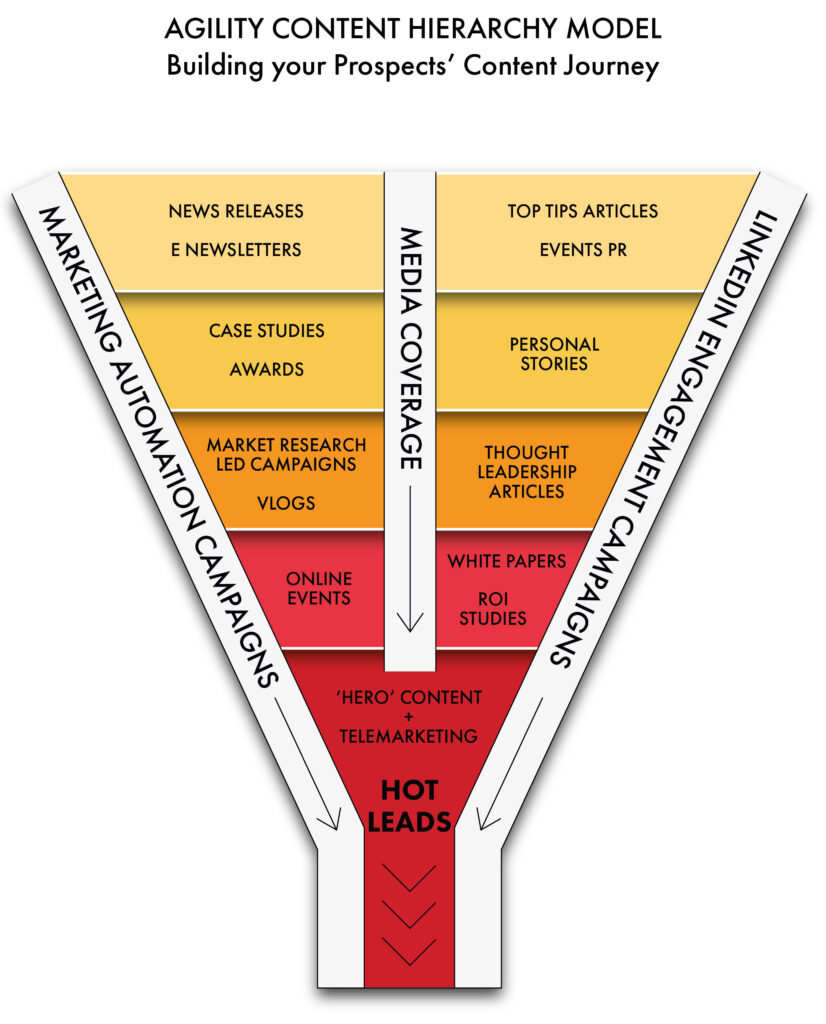Agility PR’s founding client invented the world’s first network camera in 1996, became the industry leader in the IP Surveillance market it created and was purchased by Canon Inc. in early 2015 for $2.8bn. Today it has annual sales in excess of £1bn and employs more than 3,700 people around the world. That company is Axis Communications.
For this post, I interviewed Kristina Tullberg who is the Communication Manager for Axis in Northern Europe. She is also the editor of the Axis regional partner magazine #AxisInnovates. Pre-lockdown she divided her time between the Axis Nordic head office and Axis UK office. The below is the second of a three part Q&A-style article based on a conversation Kristina and I had at the end of November. I hope you find her insights into the connected worlds of digital marketing, content creation, content marketing and external communications in general as interesting as I did.

Kristina Tullberg, Communications Manager, Northern Europe, Axis Communications
Q3. Do you think we will be talking about what we do today as Marketing, PR, or Marketing Communications a few years from now?
A3. The word marketing is very broad. It’s my personal opinion that the concept of what marketing is and does has already changed and it will continue to evolve. For example, marketing has already become much more technical. The introduction of marketing automation systems and social media engines both require technical capabilities. Data driven marketing has become real. Since my heart still lies with content, I will of course argue for the power of the written word and for well-scripted and planned video content. This focus will remain the same. However, the context and the channels are changing.
Q4. As a large corporate enterprise, what type of content do you need to think about?
A4.
Umbrella Topics
Start with your Thought Leadership ‘umbrella’ or platform topics. These are the core topics which also communicate something of the values of the business. Is it about quality design, functionality, green credentials, or something else? Work hard to define and communicate those consistently. Then underneath those umbrella themes you need to build content which helps articulate the value of those platforms for specific sectors, customer groups and partners.
Tech ‘mega trend’ content
You also must address the latest tech buzz phrases which are perceived to be impacting all markets. You must have your take on smart cities, augmented reality, AI, IoT, ‘Cloud First’ etc. You need to put your interpretation on those tech ‘mega trends’. What do they mean for the markets you sell to? How have you absorbed this new thinking into your products and services? What does your industry’s adoption curve look like for each of these? Can you communicate this?
Sales & Partner content
Then you needed to think about sales content. Think about the decision maker and try to build up a detailed picture of him/her – an avatar if you will. It might be an installer working with schools and colleges for example. They are likely to be interested in some educational pieces which help explain how some security threat could be mitigated. Or how one product might be configured to work well with another, more practical tips and tricks-type content. Then you need to think about the format: is it an instruction video, an article, or a vlog?
Q5. What’s the big danger with creating all these different layers of content?
A5. The big risk is not tying them together and not making it relevant to the audiences which you need to engage. So, you could mount a really interesting corporate campaign on a mega trend like Smart Cities. However, if you don’t explain what that could mean at installer-level i.e., provide your partners with an entry point into smart city projects, then you are not making it real enough. The communication will, on its own, struggle to translate into real engagement and thus sales.
“The trick is that the right type of content needs to reach the target audience when it’s most relevant for them. And then, once engaged with that thought leadership content, they need to be served other types of content in a logical way. Few want to jump from a short news piece to a 40-page technical white paper for instance.”
But they might go by stages in the direction of more detailed content. Then the task is to keep your engaged leads in the ‘virtual room’. To do this, you want to keep offering them new relevant insights, unique opinions, opportunities to debate the topics raised…keeping them engaged.
“The biggest challenge remains qualifying them to a level when you can classify them as a really hot lead and pass them onto sales with great confidence. The interaction with sales should be relevant not only to the sales staff but also for the customer… no one is up for a cold call these days.”
Q6. How do you deal with multiple language requirements once you have identified content which you know is of value across Northern Europe for example?
A6. We have a corporate translation agency we use. But then you need to proof read, and sense check it to make sure nothing has been lost in translation. Some of this is cultural. For example, English people use a very broad vocabulary, a very large range of words. Whereas the Swedes use fewer words and express themselves differently.
A straight translation without localised adaptation by a Swedish speaker would render the piece meaningless or even a bit silly to a Swede. If you don’t do this localisation work you may as well keep it all in English.
Q7. What content changes have you had to make as you’ve transitioned to digital marketing?
A7.
Top Tips content
We’ve had to create a larger quantity of shorter pieces, broken up with clear sub headings and written in a more direct and didactic style. Why has this proved necessary? The sheer volume of information which your average business reader is being targeted with in a typical day demands it.
“Attention spans have naturally fallen as volumes of information have increased. There’s been a trend away from deliberative and discursive language and in the direction of more direct, educational, informative, and factual content.”
Personal stories
However, it’s not all top tips and hard facts. We’ve also found that more personal, warm-hearted, and down to earth stories have gained ground. The good articles and vlogs in this category tend to convey real world experience and are written in a more direct tone.
“We’ve noticed as the pandemic has gone on, this sort of content engages and builds relationships with our customers increasingly effectively. It is also shared more widely (on social channels) and achieves stronger reach than more typical content.”
Video content
Also, we are seeing a great deal more video content. If you can watch something and learn in 3 minutes what might require 15 minutes to read in a 2,000 word article, why wouldn’t you do that now? Younger people have no tolerance for long introductions and not getting to the point rapidly.
Thought Leadership content
“Thought Leadership Content does not mean that there is no place for longer thought leadership pieces. However, you just need to know precisely what the audience is for that piece and do not try to generate leads from it directly.
The communication objective might be to create a space for reflection – to communicate your points of view in more detail, or to bring them around to your way of thinking on a new trend. If I’m honest, this is the toughest content to create and we could do even more of it today. It involves a good deal of original thinking.”
It simply cannot be cut and pasted from somewhere else.
Market Research-based content
Last but by no means least, we’ve found the genuinely new insights which market research-led content offers us has gained ground in recent years. Both business and consumer surveys form a good basis for any campaign if you are dealing with a new area where people really need to understand more about it.
em>“Research adds proof and therefore weight to your views and opinions about new developments. They generate thought provoking content. Further, they show you are in touch with these new developments. Better than this, you are adding to the debate and the body of knowledge around a relevant topic in a meaningful way. What’s not to love. Everyone loves statistics. They help us make sense of the changing world around us.”

Top 6 Tips for Building Your Content Journeys
Top 6 Points I took from this part of my conversation with Kristina were:
1. Start building you content hierarchy at the top – with the umbrella topics which are core to your companies corporate brand and differentiate you from the competition.
2. Technology businesses should aim to offer their own unique spin on the current global megatrends as well as insights linked to your industry-specific mega trends like Smart of Safe Cities in the physical security market.
3. Remember to tie different types of content together into coherent campaigns which work to aid deeper engagement with your company.
4. Recognise that there is a place for a wide range of video and written content from a 1 minute video explainer right through to a 3,000 word white paper or online discussion on an emerging mega trend.
5. Opinion-based thought leadership content which makes sense of the changes which are going on in the market you are serving, are perhaps the hardest content pieces to create because they require proper research, expert analysis and original thinking.
6. Market Research can provide a springboard into that thought leadership content because if you’ve commissioned that research and designed it correctly you create a source of new insights which give you greater authority and more ‘airtime’ to express your differentiated views and opinions about the way things are changing.
The big consulting groups have been doing this stuff for decades – now is your chance to ‘own’ a key topic which is likely to impact the selection of your products, services and expertise.


Recent Comments